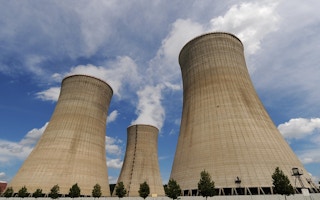Two years after catastrophe at Japan’s Fukushima plant, sellers of atomic reactors woo potential buyers with the promise that lessons learned from one of the world’s worst nuclear disasters make the technology safer than ever.
The March 2011 earthquake and tsunami triggered meltdowns and radiation leaks at the plant, 150 miles northeast of Tokyo, causing widespread contamination and prompting mass evacuations.
The shockwave through the nuclear industry has not subsided and Fukushima plant owner Tepco is still struggling to contain the consequences. Last month the firm said new spots of high radiation had been found near storage tanks holding highly contaminated water, raising fear of fresh leaks.
Barbara Judge, a UK-based nuclear expert appointed by Tepco to improve its safety culture, says the disaster has made safety the top priority.
“My opinion is that after Fukushima everything will be safer and that the safety agenda will be first in everyone’s minds,” she said
In the aftermath of the accident many reactor developers reviewed their designs following government guidance and engaged in deep soul-searching that continues more than two years later.
Germany, with a traditionally anti-nuclear voting force, went as far as completely shunning nuclear power, vowing to switch off its nuclear fleet by the early 2020s.
As a consequence of the political rethinking on nuclear power after Fukushima, companies such as France’s Areva, Toshiba’s Westinghouse unit or GE-Hitachi have seen orders dry up and costs for new plants explode due to additional safety requirements set by regulators.
At the end of 2010, 120 nuclear reactors were planned across the world. By the end of last year this number had dropped to 102, according to statistics published by the International Atomic Energy Agency.
The International Energy Agency (IEA) also scaled back the 2035 nuclear capacity forecast by some 50 gigawatts in its latest World Energy Outlook due to policy changes.
“The prospects for nuclear power worldwide have been clouded by the uncertainty surrounding nuclear policies after the Fukushima Daiichi accident in March 2011,” said IEA analysts in the outlook.
In a bid to win new business, nuclear reactor makers largely ignore references to the Fukushima accident in marketing material, and those who do refer to it say the event has made their designs safer.
“Since March 2011, the context has changed, but the fundamentals remain the same,” Areva’s chief commercial officer, Tarik Choho, says in a statement in a brochure promoting the company.
Areva has long realized that chasing nuclear customers alone is not a sustainable business and has been selling renewable energy technology alongside nuclear reactors since 2006.
Its stall at the London-based annual conference of the World Nuclear Association last week had a picture of an offshore wind turbine that caught the eye before images of its nuclear plants.
In two bold examples showcasing how costly it is to build new reactors, Areva’s European Pressurised Water Reactor (EPR) projects in Finland and in its home market in France are billions of euros over budget and years behind schedule.
“Utilities worldwide are increasingly required to reduce emissions, while adapting to regional resources and producing profitable, competitive electricity - with the utmost safety,” he said.
Safer after Fukushima
Russia’s Rosatom, which is now building more nuclear reactors worldwide than any other vendor, says a safety push following the Soviet Union’s own radioactive catastrophe at Chernobyl in 1986 has given it an edge over reactors built at the height of the nuclear market in the 1970s.
“Chernobyl was a turning point for the Russian nuclear industry,” said Jukka Laaksonen, a former Finnish regulator and now a vice president in Rosatom’s export branch.
“In the 1990s, all the focus of global nuclear safety research was in Russia, testing and experiments were run here in cooperation with Western experts.”
Canada’s CANDU nuclear reactor design simply states in a marketing brochure that it can prevent severe accidents, while a Westinghouse spokesman said the company had developed and brought to the market technology that increases safety based on lessons learned from Fukushima.
Westinghouse’s AP1000 reactor can maintain safe shutdown conditions without any manual interference and without the need for power or pumps, the spokesman said.
The only nuclear reactor designer hitting the Fukushima subject explicitly is GE Hitachi.
GE’s boiling water reactors (BWR) were used at the Fukushima nuclear site, supplied by GE, Toshiba and Hitachi, putting most publicity pressure on the companies which designed and supplied the technology that was hit by the world’s second most dangerous nuclear accident.
GE Hitachi’s nuclear joint venture business, which sells the Advanced Boiling Water Reactor (ABWR), includes four pages in its marketing material dedicated to how its design has been improved to prevent what occurred at Fukushima.
“To accomplish an enhanced level of nuclear safety, supplementary safety enhancements against severe conditions have been incorporated,” the 46-page brochure reads.
“These enhancements (…) are designed to address the Fukushima-Daiichi NPP (nuclear power plant) accident caused by the huge earthquake and subsequent tsunamis on March 11, 2011,” the company said.










